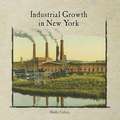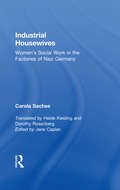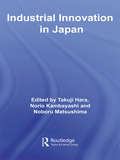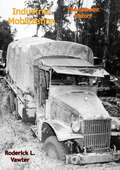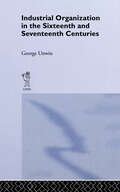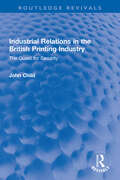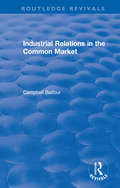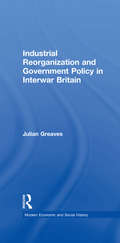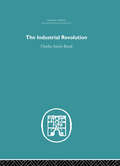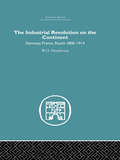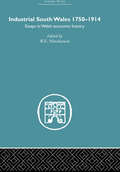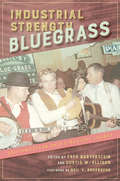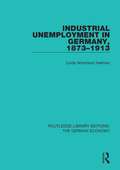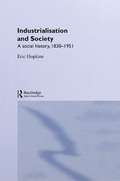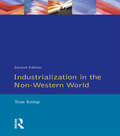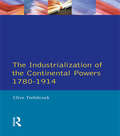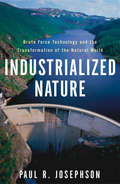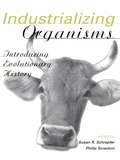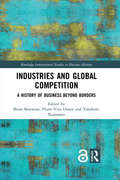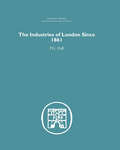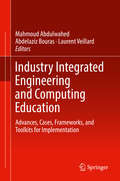- Table View
- List View
Industrial Growth in New York
by Holly CefreyA book about the growth of industries in New York City.
Industrial Housewives: Women's Social Work in the Factories of Nazi Germany
by Carola SachseFocusing on women and their work, this valuable historical study traces industrial social work from its inception through the Nazi period. Author Sachse provides an analysis of policies applied to women workers rather than developed by and for them--as an example of how social policy treats women. This thorough book examines the continuities and discontinuities of industrial social work, and assesses the effect on the industrial welfare system of developments within National Socialism. Within this framework the study examines the role of women in industrial social work and labor relations, the attitudes of various groups toward the proper relations between industry and government, and the well-documented relationship between industrialists and the German Labor Front (DAF), the organization that replaced the outlawed labor unions.
Industrial Innovation in Japan (Routledge Studies In Innovation, Organizations And Technology Ser.)
by Norio Kambayashi Takuji Hara Noboru MatsushimaIn this new book, Hara, Kambayashi and Matsushima gather together a collection of case studies of innovation in various industries in modern Japan, including automobile, electronics, semiconductor, component, chemical, pharmaceutical and service industries. Unlike other books in this area, this book focuses on a broader range of Japanese indus
Industrial Mobilization: The Relevant History
by Roderick L. VawterIndustrialization mobilization planning is an old idea in the history of modern warfare. In the United States, in fact, the National Defense Act of 1920 required the Federal Government to conduct such planning. Current reforms were inspired when, in 1978, a series of mobilization exercises revealed serious and dangerous deficiencies in mobilization planning. The basic premise of this historical study is that industrial mobilization lessons of the past provide answers for many of today’s problems. The author contends that current industrial mobilization planners should draw lessons more from the Korean War effort than from World War II. The Korean mobilization effort supported not only the demands of that war, but also the readiness needs to counter an anticipated Soviet attack. After describing the Korean experience in detail, the author examines changes in industrial mobilization planning that evolved as the nation perceived an easing of the Soviet threat. He highlights problems that, should they remain unsolved, ultimately would preclude effective industrial mobilization planning. Finally, he recommends realistic actions to restore effective planning.
Industrial Organization in the Sixteenth and Seventeenth Centuries: Unwin, G. (Routledge Revivals Ser.)
by George UnwinFirst Published in 1963. Routledge is an imprint of Taylor & Francis, an informa company.
Industrial Organization in the Sixteenth and Seventeenth Centuries: Unwin, G. (Routledge Revivals)
by George UnwinThis third impression of the second edition was originally published in 1963, and in this classic study George Unwin attempted for the first time to bridge the gap between the economic development of medieval England and the England of the eighteenth century with a detailed study of the evolution and growth of the London Livery Companies and the early craft guilds. He discusses at length the various amalgamations of the crafts, the early joint-stock enterprises, protectionism under James I, and the early development of the Trade Union Movement. In his introduction, Professor T. S. Ashton shows the importance of this pioneer study in the light of the industrial development today of the newly emergent nations.
Industrial Relations in the British Printing Industry: The Quest for Security (Routledge Revivals)
by John ChildFirst published in 1967, Industrial Relations in the British Printing Industry was written to provide a comprehensive picture of the development of organisations of both employers and those employed in the British printing industry. The book traces the story from the seventeenth century Craft Guilds and the Stationers Company, through the development of trade unions and union rule in the nineteenth century and up to the technical revolution of the early 1900s. Later chapters cover in detail problems such as restrictive practices and productivity bargaining in the thirty years prior to the original publication of the book. It also explores how their aims and strategies are related to changing technological and economic conditions. Industrial Relations in the British Printing Industry will appeal to those with an interest in social history and the history of industrial relations, particularly with regards to the printing industry.
Industrial Relations in the Common Market (Routledge Revivals)
by Campbell BalfourOriginally published in 1972, Industrial Relations in the Common Market is a comparative study of the members of the Common Market, exploring the range of industrial relations and some of the contemporary issues and problems that they faced. The book provides a comprehensive description of the Common Market, its economic growth and the diverse economies of the member countries. It also examines political parties and trade unions, and deals with the themes of collective bargaining, incomes policy, law and labour relations, industrial democracy, labour mobility and social security. Industrial Relations in the Common Market is an excellent insight into the history of industrial relations within this economic community.
Industrial Relations: Cost Effective Strategies (Routledge Revivals)
by Chris Brewster Stephen ConnockThe economic recession of the 1980s changed the face of industrial relations in Britain. Originally published in 1985, this book brings together all the major developments from that time and examines organizational strategies in industrial relations from a cost-effectiveness standpoint. Contemporary issues, ever more relevant, such as flexible working patterns, are discussed in relation to the conflicting demands of unions and management. Appropriate courses of action are discussed, with many examples of how new ideas were put into practice.
Industrial Reorganization and Government Policy in Interwar Britain (Modern Economic and Social History)
by Julian GreavesOffering a detailed overview of state involvement in the rationalisation and reorganisation of British industry between the wars, this is the first work to address the issues in a comprehensive manner for over 50 years. Utilising a range of primary source material (including papers from the PRO, the Bank of England, the Federation of British Industry and various private archives), Julian Greaves has combined a selection of detailed case studies of selected industries with a broader overview of the national political and industrial situation. The resulting work, which manages to balance analytical depth with breadth of coverage, argues that despite numerous problems and limitations, 1930s' industrial reorganisation policy was reasonably successful in meeting the limited aims of the government.
Industrial Revolution
by Charles Austin BeardFirst published in 2005. Routledge is an imprint of Taylor & Francis, an informa company.
Industrial Revolution on the Continent: Germany, France, Russia 1800-1914
by W.O. HendersonThis book was first published in 1961.
Industrial South Wales 1750-1914: Essays in Welsh Economic History
by W. E. MinchintonSouth Wales was one of the main centres of the Industrial Revolution in Britain but the story of the rapid growth of an industrial society there has not yet been fully told, since much of the work done has consisted of articles rather than books. This volume brings together a selection of important contributions hitherto only accessible in a large number of scattered periodicals. These articles have been selected to present a considered sequence and are preceded by an introduction which puts the story of the industrialization of Wales into perspective. They deal firstly with the problems of population and migration then with the basic industries of iron, coal, tinplate and copper. These are followed by essays on banking, and the volume concludes with contributions on trade unionism and building. This is by no means merely the story of regional development since the book has a wider appeal; a number of the articles are concerned with the links with America and with the place of Wales in the Atlantic economy. Amongst the authors are the late Sir Lewis Namier and some of the leading writers on the history of modern Wales including Brinley Thomas and A. H. Dodd.
Industrial Strength Bluegrass: Southwestern Ohio's Musical Legacy (Music in American Life)
by Fred Bartenstein Curtis W. Ell isonIn the twentieth century, Appalachian migrants seeking economic opportunities relocated to southwestern Ohio, bringing their music with them. Between 1947 and 1989, they created an internationally renowned capital for the thriving bluegrass music genre, centered on the industrial region of Cincinnati, Dayton, Hamilton, Middletown, and Springfield. Fred Bartenstein and Curtis W. Ellison edit a collection of eyewitness narratives and in-depth analyses that explore southwestern Ohio’s bluegrass musicians, radio broadcasters, recording studios, record labels, and performance venues, along with the music’s contributions to religious activities, community development, and public education. As the bluegrass scene grew, southwestern Ohio's distinctive sounds reached new fans and influenced those everywhere who continue to play, produce, and love roots music. Revelatory and multifaceted, Industrial Strength Bluegrass shares the inspiring story of a bluegrass hotbed and the people who created it. Contributors: Fred Bartenstein, Curtis W. Ellison, Jon Hartley Fox, Rick Good, Lily Isaacs, Ben Krakauer, Mac McDivitt, Nathan McGee, Daniel Mullins, Joe Mullins, Larry Nager, Phillip J. Obermiller, Bobby Osborne, and Neil V. Rosenberg.
Industrial Sunset
by Steven HighPlant shutdowns in Canada and the United States from 1969 to 1984 led to an ongoing and ravaging industrial decline of the Great Lakes Region. Industrial Sunset offers a comparative regional analysis of the economic and cultural devastation caused by the shutdowns, and provides an insightful examination of how mill and factory workers on both sides of the border made sense of their own displacement. The history of deindustrialization rendered in cultural terms reveals the importance of community and national identifications in how North Americans responded to the problem.Based on the plant shutdown stories told by over 130 industrial workers, and drawing on extensive archival and published sources, and songs and poetry from the time period covered, Steve High explores the central issues in the history and contemporary politics of plant closings. In so doing, this study poses new questions about group identification and solidarity in the face of often dramatic industrial transformation.
Industrial Unemployment in Germany 1873-1913 (Routledge Library Editions: The German Economy #5)
by Linda A. HeilmanOriginally published in 1991 this book provides a multi-faceted analysis of German unemployment between 1873 and 1913. It can also be read as an example of social scientific historiography during the fourth quarter of the twentieth century. Finally, the study has value for the comparative perspective it lends to current economic, social, and political turmoil in Germany, Europe, and the United States. While the precise conditions in the USA differ today, there are clearly still lessons to be learned on both sides of the Atlantic from the economic, social, and political dislocation, which accompanied industrial unemployment in Germany between 1873 and 1913. .
Industrialisation and Society: A Social History, 1830-1951
by Eric HopkinsIndusrialisation and Society provides an essential introduction to the effects of industrialisation on British society, from Queen Victoria's reign to the birth of the welfare state in the 1940s.This book deals with the remarkable social consequences of the industrial revolution, as Britain changed into an urban society based on industry. As the first nation to undergo an industrial revolution, Britain was also the first to deal with the unprecedented social problems of rapid urbanisation combined with an unparalleled growth in population.Industrialisation and Society looks at contemporary ways in which the government and ordinary people tried to cope with these new pressures, and studies their reactions to the unforseen consequences of the steam revolution. In particular, this indispensable book considers:* the Victorian inheritance* Edwardian England and the Liberal reforms* the two world wars* the Welfare State.
Industrialisation in the Non-Western World
by Tom KempThis new edition is fully updated and revised, incorporating the massive changes in the USSR and China in the 1980's. It offers a series of case-studies charting the progress and assessing the achievement of six industrializing countries outside the Western World. It covers the whole range of economic approaches, from those depending wholly on market forces to those that are completely planned.
Industrialisation of the Continental Powers 1780-1914, The
by Clive TrebilcockThe Industrialisation of the Continental Powers is both a broad survey of the process of European industrialisation from the late eighteenth century to the First World War, and also a closely argued comparative economic study of how this process was experienced by different great powers.
Industrialization in Nineteenth Century Europe
by Tom KempWritten for the layman as well as the economic historian this famous and much-used book not only presents a general synthesis of the pattern of European industrialisation; it also provides material for a comparative study by illustrating, in separate case studies, the specific characteristics of development in Britain, France, Germany, Russia and Italy.
Industrialized Nature: Brute Force Technology and the Transformation of the Natural World
by Paul JosephsonThe construction of the Three Gorges Dam on China's Yangtze River. The transformation of the Amazon into a site for huge cattle ranches and aluminum smelters. The development of Nevada's Yucca Mountain into a repository for nuclear waste. The extensive irrigation networks of the Grand Coulee and Kuibyshev Dams. On the face of it, these massive projects are wonders of engineering, financial prowess, and our seldom-questioned ability to modify nature to suit our immediate needs. For nearly a century we have relied increasingly on science and technology to harness natural forces, but at what environmental and social cost?In Industrialized Nature, historian Paul R. Josephson provides an original examination of the ways in which science, engineering, policy, finance, and hubris have come together, often with unforeseen consequences, to perpetuate what he calls "brute-force technologies"--the large-scale systems created to manage water, forest, and fish resources. Throughout the twentieth century, nations with quite different political systems and economic orientations all pursued this same technological subjugation of nature. Josephson compares the Soviet Union's heavy-handed efforts at resource management to similar projects undertaken in the United States, Norway, Brazil, and China. He argues that brute-force technologies require brute-force politics to operate. He shows how irresponsible--or well-intentioned but misguided--large-scale manipulation of nature has resulted in resource loss and severe environmental degradation.Josephson explores the ongoing industrialization of nature that is happening in our own backyards and around the world. Both a cautionary tale and a call to action, Industrialized Nature urges us to consider how to develop a future for succeeding generations that avoids the pitfalls of brute-force technologies.
Industrializing Organisms: Introducing Evolutionary History (Hagley Perspectives on Business and Culture #Vol. 5)
by Philip Scranton Susan R. SchrepferFirst Published in 2004. Routledge is an imprint of Taylor & Francis, an informa company.
Industries and Global Competition: A History of Business Beyond Borders (Routledge International Studies in Business History)
by Pierre-Yves Donzé Bram Bouwens Takafumi KurosawaChanges in the dynamics of economic activities since the last decades of the 20th century have yielded major changes in the composition of industries and the division of labor and production across different regions of the world. Despite these shifts in the global economy, some industries have remained competitive even without relocating their operations overseas. Industries and Global Competition examines how and why the specificities of certain industries and firms determined their choice of location and competitiveness. This volume identifies the major drivers of this process and explains why some firms and industries moved to other parts of world while others did not. Relocation was not the sole determinant of the success or failure of firms and industries. Indeed some were able to reinvent themselves at their original location and build new competitive advantages. The path that each industry or firm took varied. This book argues that the specific characteristics of each industry defined the conditions of competitiveness and provide a wide range of cases as illustrations. Aimed at scholars, researchers and acadmeics in the fields of business history, international business and related disciplines Industries and Global Competition exmaines the unique questions; How and why did the specificities of certain industries and firms determine their choice of location and competitiveness?
Industries of London Since 1861
by P.G. HallFirst Published in 2005. Routledge is an imprint of Taylor & Francis, an informa company.
Industry Integrated Engineering and Computing Education: Advances, Cases, Frameworks, and Toolkits for Implementation
by Mahmoud Abdulwahed Abdelaziz Bouras Laurent VeillardThis book introduces recent global advances and innovations in industry integrated engineering and computing education to academics, program managers, department heads, and deans, and shares with readers a critical perspective on future potentials in industry integrated engineering education. It covers topics and issues such as integrated engineering and computing education, part-time engineering masters programs, secure BIM learning, ethics, and IT workforce development. The book concludes with detail information on summarizing and extracting different frameworks, cases, and models into a practitioner toolkit, along with pragmatic recommendations for engineering education academics to quickly utilize, adopt, and adapt the toolkits for their own curricular development activities.
